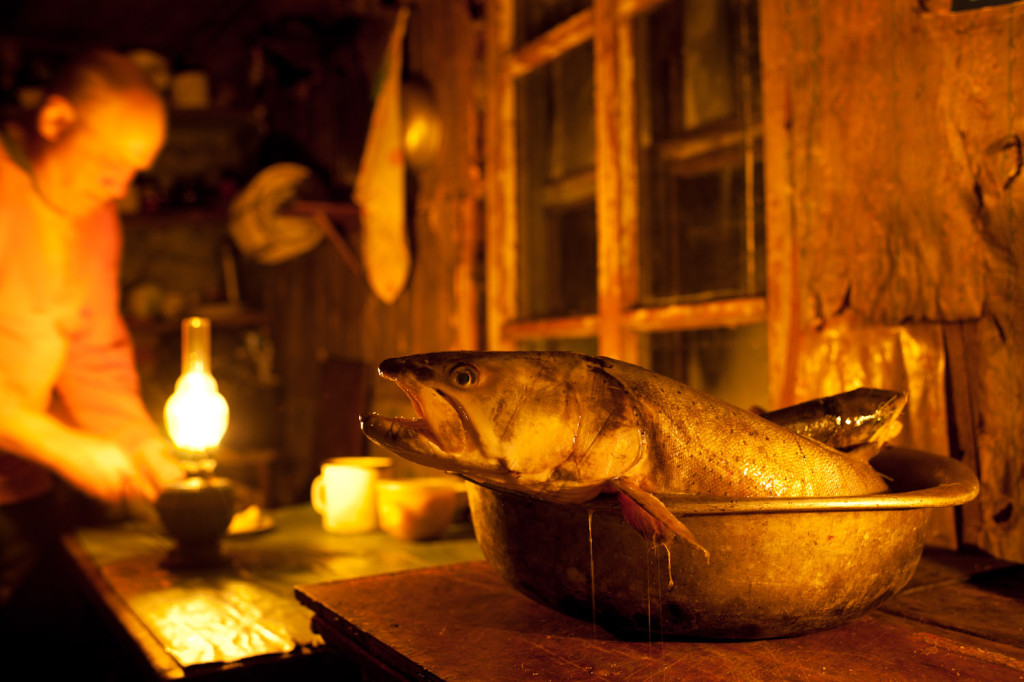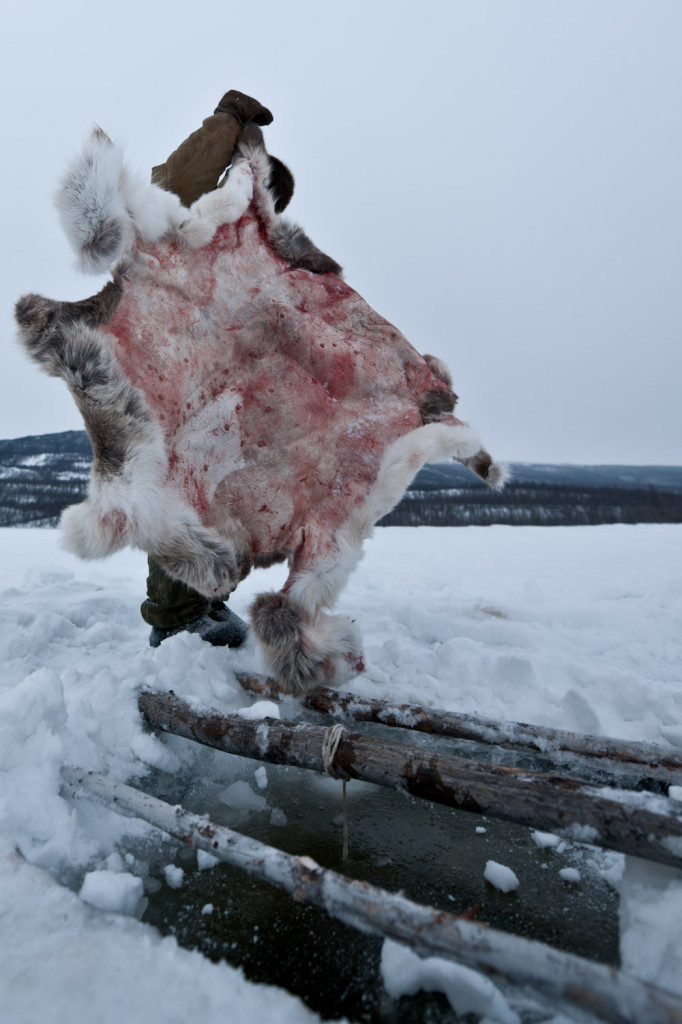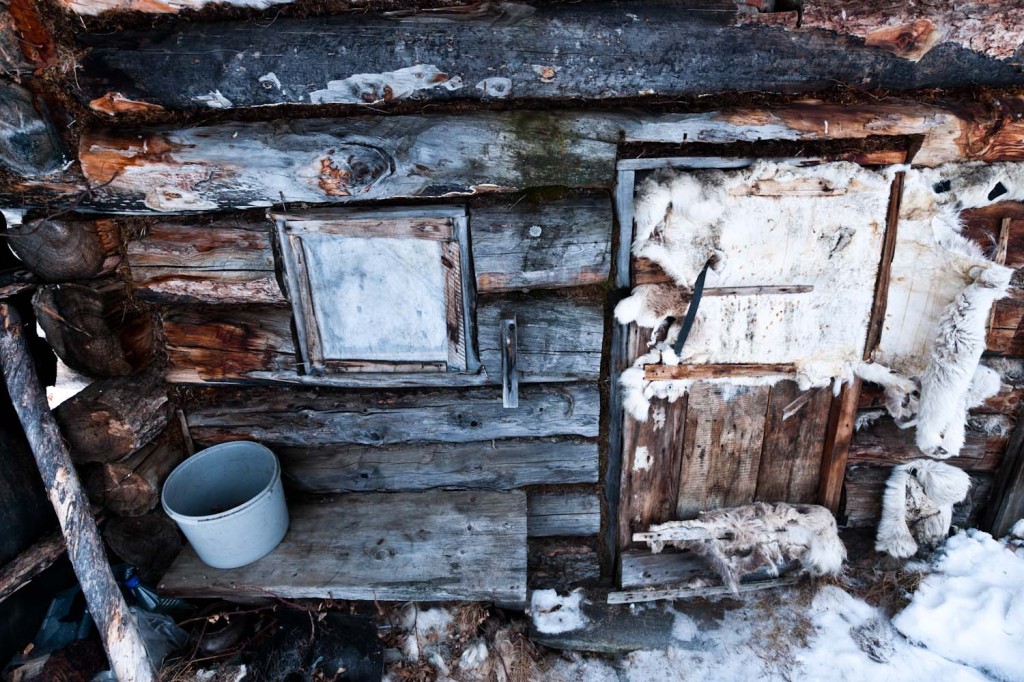Russia, Siberia, Krasnoyarsk region along the polar circle.
Evenkia:
Population – over 17 thousand inhabitants.
Area – 767 660 km2 (~1,5 France)
The capital of Evenkia -Tura
 There are two men in a boat, rowing – fleeing civilization with its rules: lost in time under a bright polar night, in amongst wild nature and the all-embracing flow of the lake-river, with a wolf gazing from one riverbank, an elk – from another. It has been raining for a week, the cold needles at tired bones. Hundreds of kilometres behind and hundreds more ahead.
There are two men in a boat, rowing – fleeing civilization with its rules: lost in time under a bright polar night, in amongst wild nature and the all-embracing flow of the lake-river, with a wolf gazing from one riverbank, an elk – from another. It has been raining for a week, the cold needles at tired bones. Hundreds of kilometres behind and hundreds more ahead.
Diupkun Lake is a place that “civilized” humans would find hard to survive. The rowers’ eyes alight upon a few dogs, and then… a fairytale-like cabin presents itself. 3 o’clock in the morning and a man emerges from the cabin to invite the strangers inside.
“It’s too small for all of us but I’m going out for now, so you can take my place. Warm up and get some rest”, – he says without any questions or surprise, as if he were expecting guests. “By the way, it’s my 57th birthday today”, – he adds.
In that moment, under a buzzing cloud of a thousand mosquitoes, a new friendship is born.
Since then, I have returned to that cabin time and again. Countless stories have been told and innumerable other subjects explained by my new friend Oleg Timofeyevich, who lives, fishes and hunts there.
Spring, summer and autumn – each lasts only one month in Evenkia. The rest of the year it’s just frozen, white winter.
The word“Dikiy”in the local language means“Wild”and is ubiquitous.Wild land,wild nature, wild man, wild animal… The reindeer which Oleg hunts, he also calls “Dikiy”. Just “Dikiy”. They are the wilderness they inhabit.
 The wooden tower in the picture lies next to Diupkun Lake, 900 m above sea level. Russian geologists intensively explored the territory of Evenkia from the 1950’s to the 1980’s. Traces of these studies still remain on the mountains, some of which are as high as 1700m above sea level.
The wooden tower in the picture lies next to Diupkun Lake, 900 m above sea level. Russian geologists intensively explored the territory of Evenkia from the 1950’s to the 1980’s. Traces of these studies still remain on the mountains, some of which are as high as 1700m above sea level.
 The Putorana Plateau covers the majority of Evenkia’s territory. In the local language “Putorana” means “flat like a table”.The Plateau is divided into hundreds of valleys that are engraved by brooks which follow different furrows every season. The hunter, watching the Putorana embelished with thousands of hissing brooks streaming down, calls them vesenije volosatyje gory (the hairy mountains of Spring).
The Putorana Plateau covers the majority of Evenkia’s territory. In the local language “Putorana” means “flat like a table”.The Plateau is divided into hundreds of valleys that are engraved by brooks which follow different furrows every season. The hunter, watching the Putorana embelished with thousands of hissing brooks streaming down, calls them vesenije volosatyje gory (the hairy mountains of Spring).
 Small villages are couched around the helicopter-landing site. The locals rarely raise reindeer these days. It is exhausting work, especially guarding them from wolves. The milk and meat that the locals can farm from the reindeer is not worth the trouble, they say. For that reason, the men have chosen to hunt. Wild deer migrate from and return to the same area every year. The locals are trapped within the chaos of hunting laws. The system of permits and legislations is too complicated for them to understand. Meat selling and transportation issues are also tricky. To my question of what we’ll be doing today, the hunter Oleg answers – “Dikovat”. From this message I understand that we are going “to hunt”. He is hoping to come across a herd of migrating deer.
Small villages are couched around the helicopter-landing site. The locals rarely raise reindeer these days. It is exhausting work, especially guarding them from wolves. The milk and meat that the locals can farm from the reindeer is not worth the trouble, they say. For that reason, the men have chosen to hunt. Wild deer migrate from and return to the same area every year. The locals are trapped within the chaos of hunting laws. The system of permits and legislations is too complicated for them to understand. Meat selling and transportation issues are also tricky. To my question of what we’ll be doing today, the hunter Oleg answers – “Dikovat”. From this message I understand that we are going “to hunt”. He is hoping to come across a herd of migrating deer.
 An experienced hunter waits for the deer to reach the centre of the frozen lake.
An experienced hunter waits for the deer to reach the centre of the frozen lake.
 That’s when he opens fire. If the deer, taking fright, turn and run from the hunter, he will aim at those in front or even at the branches of the trees on the shore. The frightened deer often turn on their hoofs, creating chaos, confusion, and death.
That’s when he opens fire. If the deer, taking fright, turn and run from the hunter, he will aim at those in front or even at the branches of the trees on the shore. The frightened deer often turn on their hoofs, creating chaos, confusion, and death.
 “In such a mess it’s impossible to avoid mistakes”, – whispers Oleg sadly, after hitting a young deer.
“In such a mess it’s impossible to avoid mistakes”, – whispers Oleg sadly, after hitting a young deer.
 The fur and horns of hunted deer will most likely not be used or sold.
The fur and horns of hunted deer will most likely not be used or sold.
 One deer produces around 50-70 kg of meet. Their tongues – a local delicacy – will probably be eaten the same evening.
One deer produces around 50-70 kg of meet. Their tongues – a local delicacy – will probably be eaten the same evening.
 The wild deer population is around 1 million and for now is quite stable.
The wild deer population is around 1 million and for now is quite stable.
 Taimen is the Eurasian giant trout, the world’s largest salmon and a dream come true for every fresh water fisherman. It is a delicious and, judged by European standards, extremely ecological dinner. But how much work must be put in before it can make it to the dinner table?
Taimen is the Eurasian giant trout, the world’s largest salmon and a dream come true for every fresh water fisherman. It is a delicious and, judged by European standards, extremely ecological dinner. But how much work must be put in before it can make it to the dinner table?
 Working in the cold requires a lot of preparation. Every step has to be planned. A perfectly sharpened ice pickaxe will save a lot of energy.
Working in the cold requires a lot of preparation. Every step has to be planned. A perfectly sharpened ice pickaxe will save a lot of energy.
 It would be much easier to cut ice holes with a mechanical saw, but the ice is too thick. For that reason, the fishermen use the traditional tool for making holes – an ice pickaxe.
It would be much easier to cut ice holes with a mechanical saw, but the ice is too thick. For that reason, the fishermen use the traditional tool for making holes – an ice pickaxe.
 It takes three hours of intense work to make 3 ice holes.
It takes three hours of intense work to make 3 ice holes.
 The men beat the ice they are standing on. It is easier to make holes that way, and it is not as dangerous as it seems. The ice structure changes near the surface of the water, it becomes softer. When the ice is broken, the pressurised water immediately fills to the top of the hole.
The men beat the ice they are standing on. It is easier to make holes that way, and it is not as dangerous as it seems. The ice structure changes near the surface of the water, it becomes softer. When the ice is broken, the pressurised water immediately fills to the top of the hole.
 Some ropes are left in the autumn to freeze into the ice. In winter, they are freed and used to hang nets between the ice.
Some ropes are left in the autumn to freeze into the ice. In winter, they are freed and used to hang nets between the ice.
 Ice holes are covered by fur, preventing them from freezing up.
Ice holes are covered by fur, preventing them from freezing up.
 During the polar nighs, thet northern lights provide an additional, and otherworldly, source of illumination. Oleg picks some firewood and returns to the cabin.
During the polar nighs, thet northern lights provide an additional, and otherworldly, source of illumination. Oleg picks some firewood and returns to the cabin.
 Most of the hunters have a few cabins in the area that they hunt in. They are usually a day walking distance from eachother.
Most of the hunters have a few cabins in the area that they hunt in. They are usually a day walking distance from eachother.
 The most valuable part of the deer is the fur from its legs. These small furs are called “Kamus” and sell for around $10 each. “Kamus” can be easily transported and sold. The government has little control over its trade.
The most valuable part of the deer is the fur from its legs. These small furs are called “Kamus” and sell for around $10 each. “Kamus” can be easily transported and sold. The government has little control over its trade.
 Every cabin is around 10 – 30 square meters and is heated by the little furnace, called “burzuika”. The word originates from “bourgeoisie”, and ironically connotes a warm and wealthy life.
Every cabin is around 10 – 30 square meters and is heated by the little furnace, called “burzuika”. The word originates from “bourgeoisie”, and ironically connotes a warm and wealthy life.
 “Labas” – is the name used for the little storage huts constructed on stilts to protect its contents from wild animals.
“Labas” – is the name used for the little storage huts constructed on stilts to protect its contents from wild animals.
 A wolf can often weigh up to 80 kg. Wolves draw inexperienced domestic dogs from their homes so that they can hunt them, but they usually back away from people. It is pretty easy for them to survive during the deer migration period. According to the government, the area is overrun with wolves, so hunters get paid for each wolf they shoot. Wolves’ fur can also be used or sold.
A wolf can often weigh up to 80 kg. Wolves draw inexperienced domestic dogs from their homes so that they can hunt them, but they usually back away from people. It is pretty easy for them to survive during the deer migration period. According to the government, the area is overrun with wolves, so hunters get paid for each wolf they shoot. Wolves’ fur can also be used or sold.

 Oleg Timofeyevich, the last Mohican living by the Dipkun Lake, is sometimes visited by his son Timofej Olegovich. When their children were small, Oleg lived with his wife Katerina. However, when their children reached school age, Katerina moved to the capital of Evenkia, Tura, so that they could attend school.
Oleg Timofeyevich, the last Mohican living by the Dipkun Lake, is sometimes visited by his son Timofej Olegovich. When their children were small, Oleg lived with his wife Katerina. However, when their children reached school age, Katerina moved to the capital of Evenkia, Tura, so that they could attend school.
 With the rise of the sun the ice begins to thin. We still ride our snowmobiles, but soon it will only be possible to walk around on foot. The locals’ life will be cut off from the rest of the country until the cold reinforces the road again.
With the rise of the sun the ice begins to thin. We still ride our snowmobiles, but soon it will only be possible to walk around on foot. The locals’ life will be cut off from the rest of the country until the cold reinforces the road again.
”Zimnik” is a winter road which is formed on the permafrost and ice. It originates from the word “Zima” meaning “Winter”. It enables vehicles to reach the remotest areas of the region only in the coldest months of the year.
Download Evenkia’s Dikiy PDF

I always imagined an African nations living a WILD life in a hot climate. Now I see it’s possible in a frozen Earth’s areas as well. Thank you for such an interesting report! It would be nice to know a little more about local people temper. I suppose it’s really different because of living in cold, only dark or only bright period and with no amenities or entertainments in daily life.